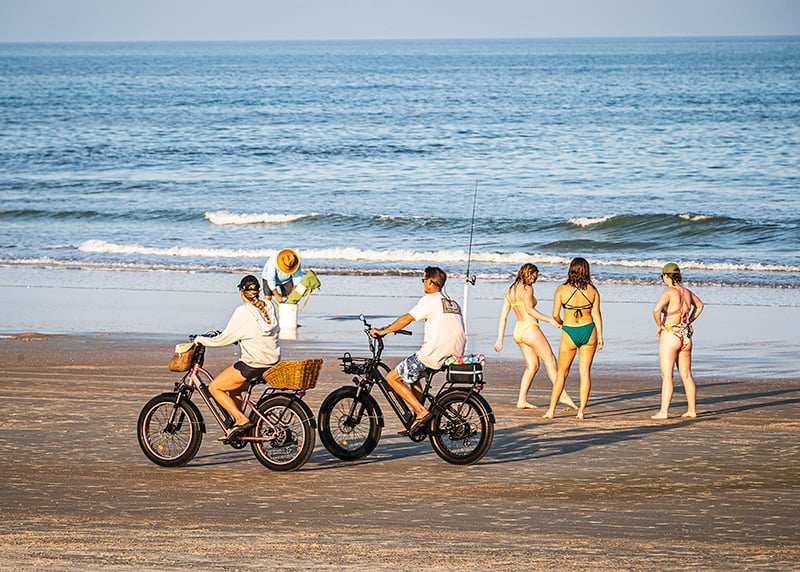Rediscover Orlando: Stay Sunshine State
Lightning, heat, and drownings are among the hazards hiding in Florida’s natural beauty.
Ralph Waldo Emerson advised his contemporaries to “live in the sunshine, swim in the sea and drink in the wild air.”
But the 19th-century poet and essayist lived mostly in New England, where heat-related illnesses were comparatively rare and the odds of a jellyfish sting or shark bite in the sea were probably less likely than in Florida.
As for the “wild air,” Emerson surely was referring to the gusty summer breezes in his native Massachusetts, not the hurricane squalls or tornadoes that can threaten the Sunshine State for half of each year. Or the rising pollen counts that occur year-round but worsen during the summer months, making it hard to breathe.
And yet, despite such perils, the allure of Florida’s natural beauty remains strong among residents and tourists alike—drawn to an outdoor lifestyle and the luxurious resorts dotting its many pristine beaches and rich, tropical landscapes.
More importantly, most of the risks that can mar or ruin a safe, healthy, experience vacationing or living in Florida, experts say, all carry preventive aspects to them.
HEAT-RELATED ILLNESSES
Heat-related illnesses, for example, though they account for the highest number of emergency room visits on a typical scorching day, can be prevented by keeping well hydrated, wearing light clothing and avoiding exertion under the midday sun, according to public health officials and ER physicians. An elevated body temperature, poses a wide range of health concerns, they say, from mild heat cramps to heat exhaustion and heat syncope—in which an individual simply passes out — to heatstroke, a medical emergency requiring intensive care.
“Sometimes, a person is bad enough, they look like they have a severe case of flu, their electrolytes are so out of whack,” says Dr. Josef Thundiyil, an ER physician at Orlando Health Orlando Regional Medical Center, referring to the minerals that keep normal body temperatures in check.
But how physicians treat each case depends on the patient’s age and comorbidities, or other health conditions, such as diabetes, which can influence subsequent care, he says. “While a young person might be able to go home and drink fluids and be fine, an older person with other medical issues might find it harder to deal with on their own,” Dr. Thundiyil says.
At AdventHealth Orlando, ER physician Dr. Kimberly Horner also sees “a mixture of everything” in the emergency room when it comes to heat illnesses. In general, she says, infants and the elderly have the highest risk for these medical events, especially heatstroke, which can be deadly, once body temperatures soar above 104 degrees. However, heatstroke is the rarest of these conditions—sometimes, but not often—caused when young children and older adults are left inside hot, locked cars, she says.
“We do see it, but we don’t see a lot of it,” Dr. Horner says, presumably because public-health messaging about the risks of heatstroke in these situations, even in our pets, seems to be working. “Many people now know cracking the window open just a little (in a car) isn’t enough,” to prevent these life-threatening events, she says.
DROWNINGS AND LIGHTNING STRIKES
The other two health hazards more common in Florida than elsewhere in the country are unintentional drowning deaths, mostly in young children, and lightning strikes.
In 2021, Florida health officials reported the most drowning deaths in the state in nearly 12 years, up 30 percent. And, drowning is still considered the leading cause of unintentional death in children ages one to four years in Florida, the highest in the nation.
“We do see a number of pediatric drownings regularly every year, despite more drowning awareness,” Dr. Thundiyil confirms. And, while there are some “near misses,” in which a child survives without significant damage, he says, “true submersions usually cause death or permanent brain injury” from the prolonged loss of oxygen.
Heading into summer, Dr. Thundiyil and others offer basic tips for water safety to prevent further tragedy: never allow children to swim alone, cordon off access to home swimming pools, begin teaching kids how to swim at an early age, and keep a watchful eye when they’re near unfenced ponds, lakes and canals. Because some of these drownings happen even at bath time or while toilet training, they say, constant supervision is needed. As for lightning strikes in Florida, medical consequences vary, depending on whether an individual takes a direct or indirect hit, according to Dr. Thundiyil. “When someone is standing next to a tree, a lightning strike might knock them over,” and recovery may be quick, he says. However, a direct hit, if an individual survives, can cause paralysis for several days, before reversing, he says.
Dr. Horner describes these lightning-associated medical emergencies at AdventHealth Orlando as rare, despite Orlando’s nickname as the “Lightning Capital of the World.” Most patients who get to the hospital in time, she says, are treated for burns in the area of impact and monitored for cardiac problems, prior to release, as a lightning strike can stop the heart.
PREVENTION TIPS
Health professionals view their prevention, however, as largely self-explanatory.
The Centers for Disease Control and Prevention in Atlanta, Ga., recommends checking weather forecasts regularly before going out and “when thunder roars, go indoors,” to a safe enclosed shelter.
If that’s not possible, the federal agency says, crouch or get low to the ground to reduce the chances of being struck, but don’t lie flat, and never shelter under an isolated tree. Also, immediately get out of and away from water, or objects that conduct electricity.
Keep an eye on the skies, watch out for the young and old and dress for the weather! It can mean the difference between spending the day having fun or spending it in the ER.
Trouble in Paradise
Our subtropical wonderland does come with some risks, but a little caution can keep adventures running smoothly.
Florida is no different than any other state when it comes to hazards big and small. We have them, by land, sea and air. Present even on a sunny day, rip currents pose dangers to even the hardiest swimmers, as these fast-moving channels of water pull beachgoers away from shore.
Rip currents along Florida’s Atlantic Ocean and Gulf Coast beaches account for more fatalities than tornadoes, lightning, flooding and tropical storms combined, according to the Florida Division of Emergency Management.
Since 1995, the division reports, more than 300 people in Florida alone have drowned in rip currents, which can pull a swimmer out to sea at 1 to 2 feet per second. Some rip currents have been clocked at 8 feet per second, according to the National Oceanic and Atmospheric Administration.
And yet, many vacationers and some residents remain unaware of these hazards, safety officials say. Awareness is key to a safe day at the beach, so coastal counties post informational signs to educate visitors and lifeguard stations fly marine hazard flags for current conditions.
If you’re caught in one of these currents, experts advise, do not panic. Stay calm and begin to swim parallel to the shoreline. If you cannot swim out of the current, float on your back to conserve energy. Call out to lifeguards and other beachgoers, waving your arms to be seen. Once the current weakens, swim parallel to the shore and allow the waves to bring you back to the beach.




